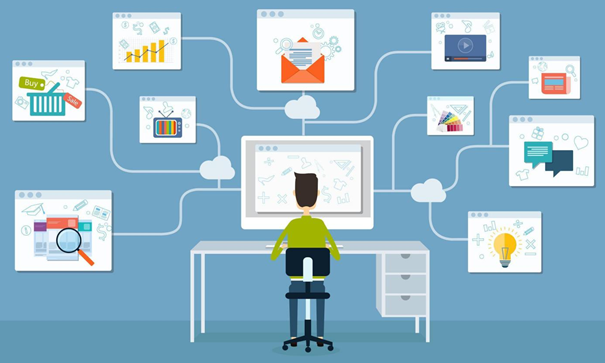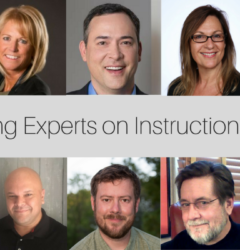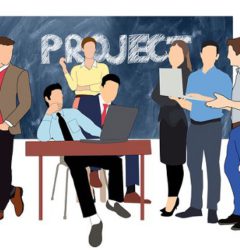8 Reasons Why Blended Learning Is Becoming a Trend
08 Aug

Table of Contents
ToggleThere has been a lot of talk about educational methods and the fact that they haven’t significantly changed in the last century. This piece of information sure sounds strange because the whole world has grown in that time and developed thanks to technology, and yet somehow, school systems have stayed the same.
The world has become saturated due to the growing devices — personal computers and smartphones — and their potential still hasn’t been used for the purposes of studying. Finally, the term blended learning had been formed; a new system of learning and directing education.
What is blended learning?
Also popularly known as hybrid learning, this method of learning combines classroom and online education. In simple words, it focuses on the integration of digital tools, techniques, and materials with the physical classroom. A blended course allows learners to view lectures, access course content, ask questions and even finish assignments online.
Dr. Clayton Christensen, well-known for his academic work on disruptive learning, estimates that half of all K-12 schools will be using blended learning by 2019. A report by RAND Corporation completed in conjunction with the US Department of Education states that a successful blended model helped improve student performance. When a group of middle and high school algebra students learned via a blended learning model, it showcased significant gains in performance (8 percentile points, in fact).
So, let’s see why this system is gaining widespread attention.
1) Ensures Effective Mix of learning Methods
The term “blended learning” represents a formal education program that brings together the best of classroom and online learning. Learners and educators like blended learning because it complements classroom learning in the right way.
To be more precise, when a student engages in an online program supported by blended learning, he or she is assigned a teacher who will establish a pace based on the student’s progress and capabilities.

2) Flexibility in terms of availability — Smartphones and Apps
Mobile device ownership is rising at a rapid pace. Research predicts that in the growing number of smartphone users, learners account for a large number of this. Mobile technology brings many benefits to the e-learning space. In fact, many feel that since mobile learning came along, online course creators are now better positioned to create customized blended learning courses. Thanks to the robustness of today’s mobile devices, many of the barriers to successful blended learning solutions are easy to address now.
Since mobile devices can make learning easy to access, educational systems should not discourage students from using their smartphones. Blended e-learning benefits from the use of a smartphone; anyone can navigate through courses without previous training. This is thanks to the intuitiveness of today’s young learners and the accessibility of modern devices. You can study during the weekdays or weekends, as per your schedule.
Apart from this, there are more and more apps popping up every day that have an educational purpose. U.S. Geography by Discovery Education is developing an app that will not only be a regular learning medium but an app that takes the location of a user into consideration and provides them with contextual content about nearby monuments, museums, etc.
3) Engaging Interaction
For most students, having discipline in their routine can be an issue as well as organizing their schedules around education. That is why a student/teacher relationship is considered necessary here. Depending on a student and their learning habits, a trained mentor can create a schedule for them.
An individual approach such as this one is exactly what a regular school fails to offer. In a physical classroom, everyone has to participate in the same program, and teachers in charge of those classes can’t tend to each person in the group with such specific attention. But with blended learning, a student will be provided with an engaging experience right from the comfort of their home.
4) Supports Self-Directed Education
Physical classrooms can’t always support self-directed learning. Dropouts are high in physical classrooms because students lose interest in their program when they are compelled to attend a group of classes bounded by time and space.
When a person enrolls in a blended learning program, they can direct their education according to their interests. Moreover, it also enables participants to acquire expertise in their field of choice at a faster pace.

5) Spending Quality Hours Online
Blended learning aids in solving one of the most common problems students have — spending too much time online. It’s obviously impossible for young people and everyone else, as a matter of fact, to stay away from social platforms because that’s exactly where their friends and family are.
eLearning courses are slowly but efficiently overtaking social networks. Considering the nature of this learning method and the fact that it’s done online, support groups are created simultaneously with learning groups. So, when a student takes up a blended learning course, they will have a Facebook group or a Twitter list to turn to for additional guidance or probably to share their user experience. Such peer-guided learning adds to engagement and value derived from the course.
6) It is Cost-Efficient
Another issue which many students face is monetary support or the burden of student loans. Even if they do manage to pay for their education during the school year, many of them are still stuck later paying off loans.
Considering the fact that blended learning enables students to select their own courses and direct their education, it’s definitely less time-consuming for them to become working professionals. eLearning is, either way, less expensive, but if you also count the number of courses that is smaller, the overall price decreases significantly.
7) Keeps students focused & improves knowledge retention
It’s true that all students, irrespective of their age, learn differently. And blended learning is the best approach because it can support both offline and online teaching methods. It allows the instructor to create a course that teaches visual, auditory, and kinetic learners alike.
If you are using a learning management system (LMS) for blended learning, educators can evaluate the efficiency of the training content by judging students based on test/quiz results. If a learner continues to face difficulties, it indicates they need additional support. All in all, a blended learning design supports the needs of students while ensuring overall knowledge retention.
8) Improved Teaching Conditions
Blended learning is capable of tearing down the conventional brick and mortar approach to teaching and helps to improve conditions like — curtailed isolation, enhanced collaboration opportunities, and professional development that is meaningful.
Blended learning helps teachers to be more efficient because it allows combining a variety of learning environments into one classroom — and often taking those teaching techniques beyond the realm of a classroom. While the blended learning approach is preferred by learners, it benefits the teachers as well because it allows them to make learning fun and interactive.
Why businesses prefer a blended learning approach?
The use of technology in the corporate world has been responsible for the positive opinion about blended learning techniques. It helps streamline the training process and is capable of supporting the learning needs of a large number of students, all across the globe.
For the corporate learners, a blended learning approach works because they can access learning content that is not confined within the “four walls”. Students benefit from different learning channels and media formats as blended learning can support a variety of learning styles.
It is appropriate to say that a blended approach to learning is more learner-centric. It never restricts the learners or forces them to depend on one source of information. In a situation, where they miss a face-to-face session, they can find that information elsewhere, promoting the concept of self-paced learning.
Summing Up
All the advantages of blended learning that have been mentioned above make existing systems look outdated and old-fashioned. To improve information retention, engagement, and teaching, blended learning is more important than ever, regardless of the industry, from schools to corporations.
Much like blended learning, micro-learning is also a growing trend, which allows users to consume the content in smaller portions. This is another way to make it easier for students, especially those with shorter attention spans, to gain more from their coursework.
Written as a guest post for the zipBoard blog by Kamy Anderson.
Build blended learning courses with zipBoard
Request a personalized demo to help your entire team stay on the same page, whether it’s blended learning or adaptive learning, and build e-learning courses collaboratively
Get DemoRelated Post
Recent Posts
- Best Practices for Efficient Document Reviews and Collaboration December 18, 2025
- MEP Document Management: How to Streamline Reviews & Avoid Rework October 3, 2025
- What Is Online Proofing Software? And Why Content Review Breaks Without It July 11, 2025
- How Laerdal Medical Cut eLearning Review Time by 50% with zipBoard’s Visual Review Tool July 9, 2025
- Why Your Team Needs a Content Feedback System (Not Just Comments in Docs) May 28, 2025
©️ Copyright 2025 zipBoard Tech. All rights reserved.


